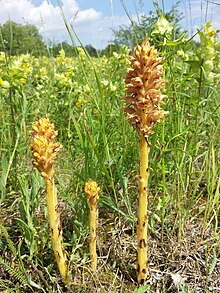Phytoparasitism
As a parasitic plant ( ancient Greek παρά para "beside" σιτεῖν sitein "fatten feed") refers to the parasitic resources acquisition of plants . You acquire some vital resources by means of a host plant , which is often used to supply nutrients .
In the case of phytoparasites, a distinction is made between the following two groups:
Parasitic flowering plants
The parasitic flowering plants parasitize directly on other flowering plants with the help of special organs ( haustoria ). They can be further subdivided according to criteria, namely
- physiologically according to the extent of chlorophyll loss in
- still green semi-parasites ( hemiparasites ; example: mistletoe ) capable of photosynthesis and
- parasitic parasites ( holoparasites ; example: summer sausage ),
- or anatomically -functionally according to the type of host tissue parasitized in
- Vascular or xylem parasites (examples: mistletoe, flake root ) and
- Sieve tube or phloem parasites (examples: silk , summer herbs ),
- or morphologically according to the location of the infected host organs in
- Sprout parasites (example: mistletoe, silk) and
- Root parasites (example: scale root , summer root ).
It used to be assumed that the semi- parasites were vascular parasites , whereas the full parasites were sieve tube parasites . The two pairs of concepts are not entirely congruent , since as the full parasites lathraea there that still tap into their host plants, only the xylem, and also semi-parasites like the mistletoe also Phloemkontakt may have. In addition, the boundary between hemi- and holoparasites is not as clear-cut as the definition suggests. For example, the alpine throat ( Tozzia alpina ) lives underground as a full parasite in its first stages of development, but turns green after breaking through the surface of the earth and henceforth feeds as a semi-parasite.
Myko-heterotrophic plants
The myco-heterotrophic plants (MHP) emerged from mycorrhizal plants in which the mutualistic symbiosis has shifted towards parasitism. They no longer only receive water and nutrient salts from their fungal partner, but also organic carbon compounds. The mycorrhizal fungi of the myco-heterotrophic plants can be saprotrophic or parasitic. In many (possibly most) cases, however, it is mycorrhizal fungi that form ecto- or arbuscular mycorrhizas. Their symbiotic partners (forest trees) are the original source of the carbon transferred from the fungus to the myco-heterotrophic plant.
Also among the myco-heterotrophic plants there are chlorophyll-free (fully mycotrophic) species such as the spruce asparagus and the bird's nest root and species that still have leaf green and are only partially myco-heterotrophic (PMHP) or mixotrophic (examples: white wood bird , small-leaved stemwort, Purple thingy , coral root ).
swell
- ↑ Hubert Ziegler: Lathraea, a bleeding juice parasite . In: Reports of the German Botanical Society 68 (1955), pp. 311-318.
- ↑ G. Sallé: Le phloeme des cordons corticaux du Viscum album L. (Loranthaceés) . In: Protoplasma 87 (1976), pp. 17-25.
- ↑ Hans Christian Weber: On the biology of Tozzia alpina L. (location, host plants, development, parasitism) . In: Contributions to the biology of plants 49 (1973), pp. 237-249, ISSN 0005-8041
- ↑ JR Leake: Myco-heterotroph / epiparasitic plant interactions with ectomycorrhizal and arbuscular mycorrhizal fungi . In: Current Opinion in Plant Biology 7 (2004), pp. 422-428.
- ↑ Jonathan R. Leake: Plants parasitic on fungi: unearthing the fungi in myco-heterotrophs and debunking the 'saprophytic' plant myth . In: Mycologist 19 (2005), pp. 113-122.
- ↑ Martin I. Bidartondo include: Changing partners in the dark: isotopic and molecular evidence of ectomycorrhizal liaisons between forest orchids and trees . In: Proceedings of the Royal Society London , Series B 271 (2004), pp. 1799-1806.

